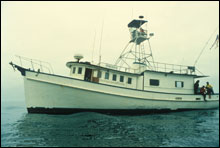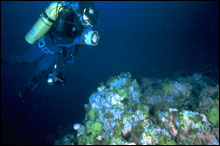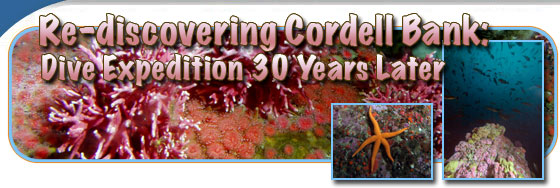Error processing SSI file
|
Hopeful return to Cordell Bank?
Bob Schmieder reflects on return to Cordell Bank
 |
| Bob Schmieder on a safety stop on one of the early Cordell Expedition dives. (Photo: Cordell Expeditions) |
This essay was written by Dr. Robert W. Schmieder, the leader of Cordell Expeditions that explored Cordell Bank in the 1970's and 80's. The essay was written prior to Dr. Schmieder's return to the Bank on October 7th, 2010 in the "hopeful future" tense.
 |
| Pisces II, one of the vessels Cordell Expeditions used to get to Cordell Bank (Photo: Cordell Expeditions) |
On our way...the boat moving gently in obedience to the engine's power, restrained as we make our way out through the harbor, past the breakwater and the cliffs, turning the corner that isolates Bodega Bay from the Pacific Ocean. The surf always piles up by the entrance, and it always generates a glitch in our thinking: will we be able to get out? Will the seas be calm enough to keep going? Will we see something remarkable on our way? On our way...on our way now...we skirt the bigger waves by Bodega Rock, and find relief in the vast expanse of deep blue. Out here, white is bad, blue is good. Today is blue; the ocean is calm. Once more, we congratulate ourselves on being so smart--October is the right time for weaklings like ourselves to pay a visit to our favorite underwater island.
Cordell Bank, 28 miles ahead. The boat is fast, so we'll be there in an hour. Not like the old days, when we chugged along at 9 knots, and took the entire morning to get there.
 |
| Cordell Expedition diver on Cordell Bank. (Photo: Cordell Expeditions) |
Lots of other things are different, too. Today we'll drive right to the shallow pinnacles, and sit smack above their tops, looking at the GPS receiver telling us we're here, within inches. Not like the old days when we had only a half-broken Loran-C receiver that located us within plus-and-minus a mile north-south and plus-and-minus infinity east-west. The funny thing about this is that if we had had such nifty navigational equipment back in 1980, we would have had a silly problem now: Cordell Bank isn't in the same place it was then! Yep. It slides along an inch or so a year. A couple of feet since we first saw the Bank. Thirty-six feet since Francis Drake sailed past.
But we won't have to worry about that today--from the surface, 150 feet above the rocky ridges, what's a couple of feet between old friends? The boat hurtles forward, and my thoughts drift into the images of Cordell bank underwater: the extraordinary aggregates of fish hovering above the garden-like landscape of colorful patches, the sponges, hydrocoral, anemones, ...
My first sight of the community living on Cordell Bank--the first sight by anyone--is indelibly imprinted in my memory, and I know that I share this image with anyone who has dived on the Bank and seen it for the first time.
But as similar as our shared images are, I know with certainty that, in detail, they are almost completely different. Hmmm? I often think of this peculiar fact when I am hiking. Take the forest on the Olympic Peninsula, in Washington State. Overall, it looks essentially as it did 2000 years ago-- you'd be hard-pressed to differentiate the two in any reasonable descriptions. But the fact is that there is not a single tree in the same place (except by accident) now as then. Looks the same, but isn't. Cordell Bank is the same. The divers today will see the same sight we saw 30 years ago, but it won't actually be the same in detail, and that's one of the aspects that makes every visit so interesting.
I imagine a time-lapse film of the 19-fathom ridge at the north end, one frame every day, running through the projector at 30 frames per second, a month in a second, 5 years in a minute. Except for the noisy flitting of the little animals--the crabs, the starfish, the snails--the colorful patches of anemones and sponges, which make up the seemingly random patchwork before us, move around with a peristaltic motion, growing and shrinking, sliding to one direction then another, disappearing and re-appearing to the side.
Squinting to blur this dazzling image, we see it scintillate, a kind of tumble-twinkling. It's hard to look away from this fascinating churning, and sure enough, now and then, something really interesting happens. What happened to the red stuff--it's all white now? Wait! There's a splotch of red again! Now the red and white patches seem to be moving across the area like waves. Now it's all red...seems like it's staying red for a long time...maybe red won. Nope, here's some yellow--didn't see that before, and it's taking over! It's the same, and different.
My imaginary movie is interrupted by the sudden change in the engine's throbbing, and I realize that we're approaching Cordell Bank. Well, it looks like every other place in the ocean, and that corny joke I have used so often inexorably rushes in: "Welcome to Cordell Bank. As you can see, this is a very special place..."
The boat tiptoes around, the skipper staring at the fathometer: 22. 23. 25. 24. 22. 19! We hit it! The shallow point is right where they said it would be. Wryly, I think to myself, "Not where it used to be!" The crew scurries about, preparing for the next human encounter with this long-lost island. In a matter of an hour or two, we'll have another frame in our movie, and it will be interesting. "Look at that!" The divers return with some specimens that will provide the scientists at the California Academy of Sciences and the U.S. Geological Survey with academic treasures, the specimens more than likely to achieve immortality in the pages of an archival journal.
As I wait for their excited return, my thoughts diffuse across the wide timeline that encompasses the dynamics of Cordell Bank: less how-things-are, and more how-things-change. My images are of the wonderful creatures that motivated their own protection within the border of a national marine sanctuary, how they have no idea of their wonderfully complex collective behavior, each living but an instant but being a part of the incessant twinkling of this most beautiful, and well-hidden, part of our Earth.
|



